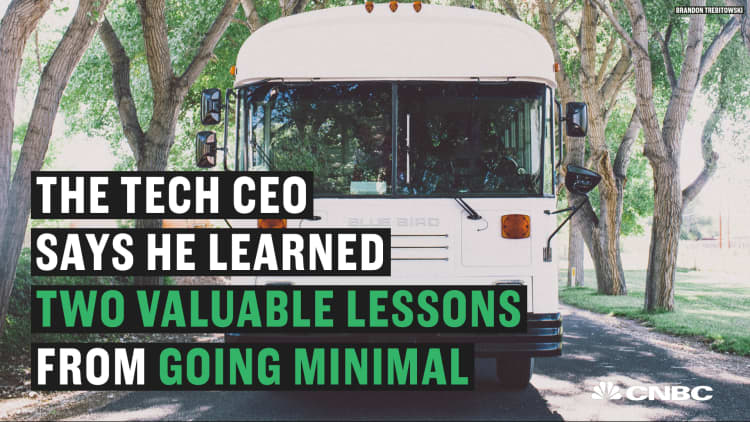If the time and money that go into buying and maintaining a house feel draining, you could always downsize.
For just shy of $26,000, you can buy a tiny home with a bathroom and kitchen delivered to you by — who else — Amazon.
Chinese company Hebei Weizhengheng Modular House Tech Co. (WZH Group), which is headquartered near Beijing, sells the 20-by-40-foot insulated, expandable container home on Amazon, which comes with solar energy panels, for $24,800, plus $1,000 in shipping.
All homes made by WZH Group are built so owners can wire them for electricity, but some also offer solar panels as an option, Ada Yin, who sells modular homes with WZH Group, tells CNBC Make It.
The kitchen and bathroom are simple, but functional. Photo courtesy WZH Group.
Yin says WZH Group has "sold many homes" in the U.S., Australia, Canada and Germany. The Amazon listing suggests a range of ways owners can use the tiny house, from home office to retail space. In the U.S., these tiny homes are more frequently lived in by families, whereas they're popular as dormitories in Germany, Yin says.
A rendering of the layout of the container home, which can expand to make more space.The key to tiny home living is not collecting extra "stuff" and keeping the space clean and tidy at all times. Layout rendering courtesy WZH Group.
Interest in downsizing your home has been growing in recent years thanks in part to a number of television shows documenting the trend: HGTV has two series,"Tiny House Hunters" and "Tiny House, Big Living," and A&E''s "Tiny House Nation" is in its fifth season. A February 2018 poll from the National Association of Home Builders found 63% of millennials would consider buying a tiny home, which is defined as less than 600 square feet. Only 45% of baby boomers and 29% of seniors felt the same, the survey finds.
TWEET: They're pretty darn good looking. The best looking house I've lived in
One reason people turn to the tiny home life is to be more environmentally responsible, says Ryan Mitchell, the managing editor and owner of The Tiny Life, an informational website about living in small homes. Mitchell, himself, lives in 150-square-foot house that he built by himself in 2012. Small homes are more "green" than their larger neighbors because they use less material to build and require fewer resources to power and maintain.
Mitchell says he's saved $100,000 in rent since moving into his tiny home, and he enjoys a simpler, more eco-friendly lifestyle.
Another reason tiny homes have been capturing headlines recently is they are relatively inexpensive and available on Amazon. The "media blitz" has been nice, says Robin Pekkala, a spokesperson for Allwood, an eco-friendly online retailer that sells a number of tiny, small and mid-sized cabin kits. But the homes themselves are not new: Allwood has been selling the wooden cabin kits since 2012, Pekkala tells CNBC Make It.
The Allwood cabin kit arrives in parts — wood, windows, doors and hardware — and needs to be assembled. If a customer wants to add electricity or plumbing that has to be done separately, Pekkala says.
Some of Allwood's structures are not made to be homes. The Solvalla model, which sells for $7,350 (with free shipping) on Amazon is more of an enclosed outdoor space. "[It's] way too small to add anything and we don't recommend doing so," Pekkala says of the structure that includes just 86-square-feet of interior space.
The Getaway (which is currently out of stock on Amazon but is available for $16,985 on Allwood's website) is larger and can be fitted with a bathroom and kitchen and is pictured below. As for the cost of additional construction? "They vary so much across geographic regions that we don't have any accurate information," Pekkala says. "Consumers should contact a local plumber and electrician for estimates."
While the Allwood cabin kits need significant construction to turn them into livable homes, Pekkala says people are doing just that.
"The larger models are being used as primary residences due to rising costs of traditional construction and the length of time involved in the process. Even our largest cabin can be assembled in three weeks, including plumbing and electrical," Pekkala says. "Another rising trend in the cabin market is that many buyers are constructing these on their existing property to be used for rental income."
While downsizing can seem like a great solution to reduce stress and financial overhead, living in a small dwelling is still not mainstream and there are some related potential hurdles: zoning laws and building regulations vary by state and even by county (the Tiny House Society has a breakdown available here) and financing options are limited and often expensive.
See also:
How a tech entrepreneur ran a 7-figure business from a bus he lived on with a wife and 3 kids
Why this Harvard grad has spent a decade making maxi pads out of banana fibers
The Seattle suburb where Jeff Bezos and Bill Gates both live is running out of money

Like this story? Subscribe to CNBC Make It on YouTube!


